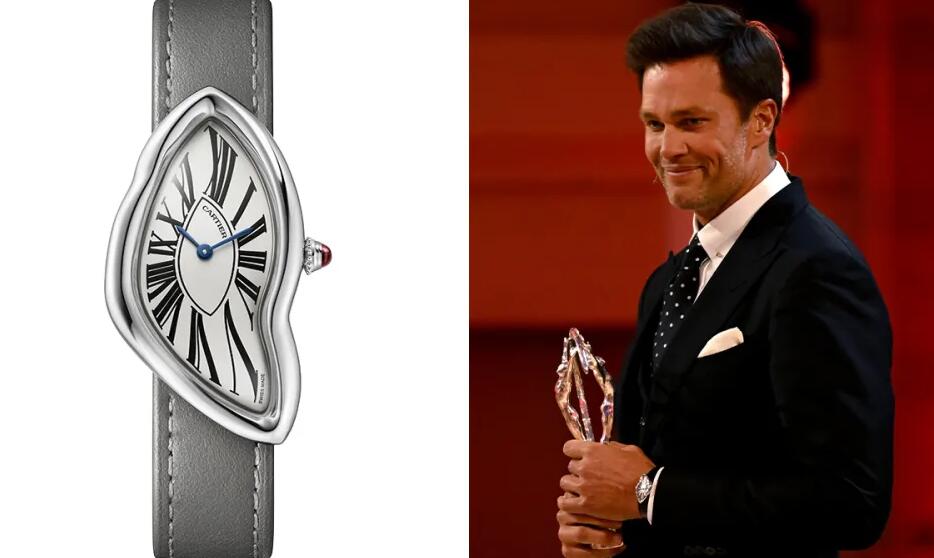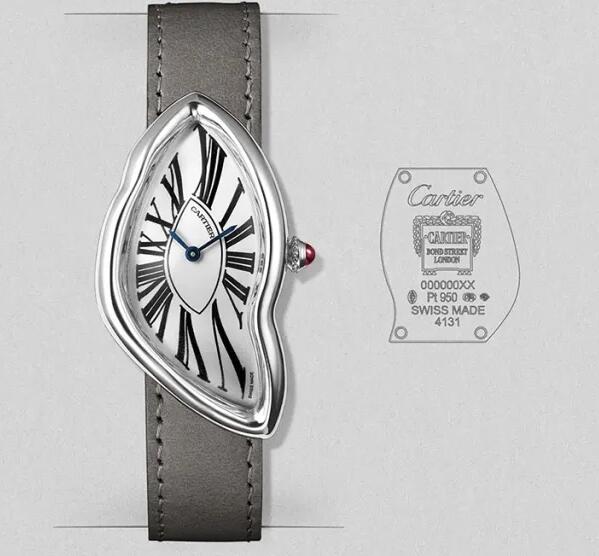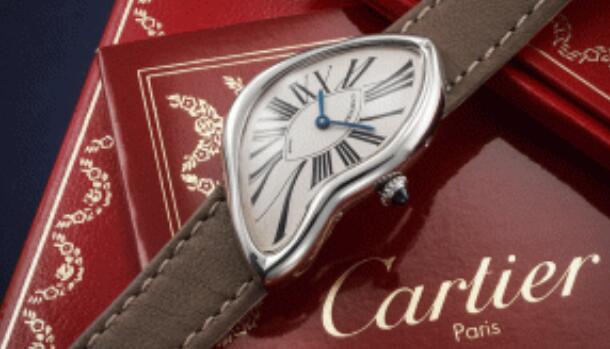The high quality Cariter Crash replica watches may be a current favorite among many watch enthusiasts, but closer investigation reveals that the twisted watch is emblematic of Cartier’s lowest moment. The struggling jewelry house created the Crash during the late 1960s as a failed late-game hail-Mary pass to London’s hipsters. I still can’t believe Mike Meyers didn’t wear a Cartier Crash while playing the James Bond-spoof Austin Powers. “Yeaaaah baby, look how weird and squiggly my watch is, baby! Yeaaaaah.” Alas, the Crash was an ill-received defilement of the studied elegance that set nearly all other UK AAA Cartier fake watches among the most revered and timeless horological designs.

As if the top replica Cartier Crash watches weren’t already a failure in and of itself, the thing’s rarity and shock-value have driven the it to the top of the must-be-seen-wearing-it list collectively maintained by red-carpet watch collectors. In April of this year, Tom Brady—arguably the greatest quarterback ever to play in the NFL, but certainly not the world’s hippest dude—sourced himself a platinum Crash, making the obscenely overpriced and already over-worn odd-ball from Cartier decidedly uncool.
In 2019, Sports Illustrated named Brady as among the most stylish athletes, but there was a hidden dig at Brady’s fashion sense in SI’s commentary: “When it comes to…his sense of style, Tom Brady has come a long way. [He] keeps getting better with age and experience, nailing sophisticated suits and subtle casual looks.” Saying someone has “come a long way” or that they’re “getting better” is always an underhanded criticism—the implication being that there was (and may still be) room for improvement. However slyly, Sports Illustrated correctly points to the fact that Tom Brady didn’t emerge from a fashion-conscious milieu with fully formed great taste.
I think it’s fair to say that American football isn’t exactly a nurturing environment for a man’s feminine side, which—I believe—is pretty much mandatory for the development of world-class fashion sensibilities. I was raised in Buffalo, N.Y.—a post-industrial city where American football has for decades held the status of a legitimate religion—and I can say with some experiential authority that, no matter how democratically widespread luxury brands and fashionable duds are these days, American football culture has yet to churn out effete aesthetes.

In other words, it’s best when the serious jocks stick to the basics, and I would agree that Brady does well with suits and subtle casual looks—just as the ever-sharp Mohammad Ali did before him, for example. But venturing into more daring fashion moves, like rocking the hyped-up 1:1 online Cartier Crash copy watches, may not be wise for a serious jock any more than it would be wise for a hypebeast (or fashionista, in my generation’s lingo) to step onto the football field or into the boxing ring. In any of those scenarios, you’re going to get knocked down. And when Brady rocked his Crash in April, the horological intelligentsia sacked the quarterback from all sides.
Last month, GQ published an article titled, “Have We Reached Peak Cartier Crash?,” citing watch expert Ben Clymer of Hodinkee as writing “the Crash is now pedestrian,” and horological influencer Brynn Wallner posting on Instagram, “Ok I love it but the Cartier Crash needs a breather.” In our own office here at Robb Report, there was a collective rolling of the eyes when Brady appeared in his Cartier Crash, with one colleague commenting that it reminded him of “those kids in college who hung posters of Dali’s melting clocks on the wall to appear smarter and more cool than they actually were.”
All this criticism brings us to the crux of my inquiry: Why, exactly, did Tom Brady wearing the luxury Cartier Crash replica watches rub so many people in the watch space the wrong way?
The easy answer, to put it bluntly, is that no matter how far his wardrobe has come, Brady will always be emblematic of mainstream America. Anyone who likes to think of themselves as being within 10 yards of current fashion’s bleeding edge will not oblige the notion of possessing even remotely pedestrian taste—let alone American taste, and most certainly not American jock taste. So, if America’s hunk of a quarterback moves into the Crash zone, then we taste-makers, influences and high-minded watch collectors will exit with our noses upturned at the stench of low-brow culture. However stuck in high school-think all this may be, American football culture and of that of urban coastal fashion elites remain at opposite ends of the playing field. And if anyone represents the other team for us life-long aesthetes, it’s Tom Brady.
That’s the easy answer as to why Tom Brady apparently wrecked the high quality Cartier Crash fake watches. But I think the problems here run deeper. We need to consider the history of Cartier’s aesthetic codes, as well as the nature of luxury branding dynamics, to understand the cultural dynamics at play here.
As for the luxury branding piece, Cartier (along with Tiffany, Halston, and others) has long struggled to maintain its appearance as a true luxury brand. As luxury market experts J. N. Kapferer and V. Bastien write in their seminal work The Luxury Strategy, “It’s important…not to fall either into a mechanical conception of luxury, made up of very high prices and Hollywood celebrities, or into an excessively traditional and historical acceptance of luxury.” This is the dynamic Cartier must navigate as a brand, and it is the same dynamic from which tastemakers—however unknowingly—derive much of their opinions of luxury brands. Clearly the tastemakers have yelled out, “That’s too much celebrity nonsense for Cartier!”
When digging into the history of the Crash itself, however, it becomes clearer why Brady wearing this specific watch was so controversial. None of this hoopla would have happened if Brady had worn a Cartier Tank, which isn’t an expression machismo by any measure. (The very feminine Rudolph Valentino and Andy Warhol regularly wore Tanks, for example.) A Cartier Tank would have slipped under the radar (not to mention the cuff) of Brady’s suddenly-excellent-yet-safely-pedestrian suits and sweaters. Unlike the Tank, the Crash is an attention-grabbing watch. It’s the opposite of the quiet elegance that has defined Swiss made replica Cartier watches since the first decade of the 20th century. The Crash wrecks Cartier’s codes of elegance.

The problem here, I’m afraid, isn’t just that we’ve hit “peak Cartier Crash” (as GQ put it), but that the Crash was a deeply flawed watch to begin with. But how did this weird watch come to be in the first place?
A very abridged history of Cartier goes something like this: A family jeweler in Paris gives birth to a genius son, Louis, in 1875, and then two other brilliant and hard-working boys, Pierre and Jacques. Over the course of the early 20th century, these three brothers build 1:1 online fake Cartier watches into the world’s most coveted jewelry house, with the Paris location being headed by Louis, the New York office headed by Pierre, and London by Jacques. London is where our story will focus, as that’s where the Cartier Crash emerged.
When Jacques Cartier passed away in 1945, his son Jean-Jacques took over the London branch of Cartier. By the late 1960s, the Cartier brand wasn’t looking terribly hip—or financially viable. Everyone in London was swinging, hippies were dancing in the streets in America, and French students were overthrowing Paris. The late 1960s was not a great moment for expensive fine jewelry.
Feeling the cultural and financial pressure, Jean-Jacques acquiesced to British actor Steward Granger’s request for a watch “unlike any other,” according to Francesca Cartier Brickell’s book The Cartiers—the Untold Story of the Family Behind the Jewelry Empire. Jean-Jacques Cartier came up with the Crash, perhaps inspired by the auto-destructive art happening in London at the time, best exemplified by Pop Art student Pete Townshend of The Who smashing his guitars. Ironically, Granger found the best Cartier Crash super clone watches too weird and returned it for something more classic. Cartier Brickell reports in her book that Cartier London only built around a dozen Crash examples, with prices hovering around $1,000 (or around $8,000 today). The watch was a total flop.
The broader Cartier business during the late 1960s was struggling. Not only were tastes shifting away from what Cartier did so well—a shift to which the Crash was certainly a concession, as was the affordable “Love” bracelet—but the era of selling lavish jewels to royalty and even Hollywood stars like Elizabeth Taylor was over. Meanwhile, the swelling middle classes were spending less on mass-produced luxury items. Cartier didn’t know how to do this kind of business, and the three branches sold out to holding companies. The London branch was the last to sell out in 1974. Psychedelic watches and cheap bracelets just couldn’t counter the economic effects of an oil-crisis and the democratization of luxury markets.
Looking back much later at the Crash, Jean-Jacques Cartier told his granddaughter Francesca Cartier Brickell that, “We should have charged more. Especially given how long each one took, tying up the workshop for an extended period. But you simply couldn’t charge too much then. There wasn’t that much wealth around. When I see what they go for today, oh my!”
Cartier’s now-famous Cartier Crash replica watches wholesale was not only an anomalous concession to off-brand aesthetics, but the Crash also failed miserably as a commercial product. By all standards, the Cartier Crash was wrecked from the get-go. Seen in this historical context, the Crash is perhaps even a little pathetic.
If, for a moment, we ignore Tom Brady and all the other folks rocking a Cartier Crash on the world’s red carpets, the Crash remains a defilement of the studied elegance that Cartier fake watches for sale had sustained for so many decades, right up into the 1960s. The Cartier Tank is a masterpiece of elegance and simplicity. Louis Cartier had worked for years in his Paris atelier to solve the problem of attaching a strap to a wristwatch in a manner that met his uniquely high standards. Except for the Crash, almost every other Cartier watch up to that point had been timeless, elegant, refined, balanced and understated.
It is these qualities that we turn to Cartier for. Not for hype, or concessions to passing fads, or attention-grabbing gimmicks. Cartier should never have smashed its proverbial guitar, and those who reach for the Crash are reaching for a failed gimmick. Perhaps the lesson here comes from Tom Brady’s own wardrobe: unless you really know what you’re doing, stick to the classics.